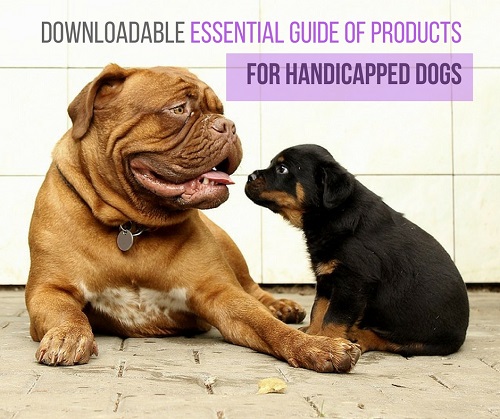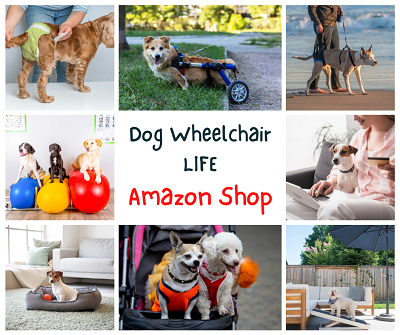
Table of Contents[Hide][Show]
Dog massage is a growing field, but you don’t have to be a professional to give a therapeutic massage to your dog at home. The techniques and the theory behind dog massage are easy to learn.
It’s a therapy that improves musculoskeletal problems, lessens anxiety and has a real impact on your pet’s quality of life, especially if you have a disabled or senior canine.
This post contains some affiliate links. Read more in my privacy statement.
Bailey’s first massage

When my dog Bailey was a puppy, I saw the effect of massage, first hand. At the time, a physical therapist was coming to our home to help my husband after an injury. When the session ended, she offered to give Bailey her own personal massage as a reward for being “good” during the treatment.
She began by rubbing the back of Bailey’s neck. It instantly calmed her down and after a minute her hind legs buckled out of under her in complete relaxation.
Bailey loved the massage and it made me a believer in the power of this therapy. Plus, it showed me the deep connection massage can have on the human-animal bond.
Becky, the physical therapist, still comes to our house when my husband’s back is bad and to this day, Bailey is her devoted friend.
Why massage works so well
Jody Chiquoine and Linda Jackson are the authors of the book, A Dog Lover’s Guide to Canine Massage. Their book talks about the importance of touch in a dog’s life and calls massage and the “laying on of hands” the oldest form of medicine known to mankind.
The authors point out that for many years pet professionals, like veterinarians, groomers and dog trainers, were the largest group to use massage to improve the health of their patients.
The benefits of massage

Massage is comforting – Dogs with health problems don’t feel well physically and are stressed. Pet owners who use massage to soothe their dog, see them unwind and relax. The physical touch of your hands reduces anxiety.
Dog massage jumpstarts natural healing – Gently massaging sore muscles and joints improves the circulation to an injured area. It brings more oxygen to the tissues and allows the natural healing process in the body to kick-in.
Post-operative massage removes toxins – Doing a light massage after surgery enhances a dog’s overall health by pushing toxins, like those from anesthesia, out of the body.
Massage improves how tissues and organs work – The way a dog digests food, absorbs nutrients, and how well their tissues and organs work all benefit with regular rubdowns.
Canine massage increases muscle function – Muscles and tendons become more flexible when they’re massaged. Range of motion improves and muscle spasms decrease.
Dog massage reduces pain and joint discomfort – Dogs with a range of pain problems stemming from surgery, arthritis, hip dysplasia, spine disease and more get relief from regular massage.
Massage increases bonding – The act of touching your dog increases the physical and emotional bond they have with you.
The basic techniques of dog massage

Note: Please be sure to check with your dog’s vet before starting any of these exercises.
Never force a dog
Another note to make to yourself is to never force a dog to take part in a massage session, especially if they’re in pain or sick. Some dogs show signs of distress by walking away, backing into the corner of a room or acting aggressively. If any of these signs occur with your pet, walk away and try again later. Dog massage is meant to be a good experience.

Get the Essential Guide
The Essential Guide of Products for Handicapped Dogs e-book is a labor of love for me. I wrote it to answer your most pressing questions about where to find the best products for your wheelchair dog. You’ll find products you didn’t know existed and each will improve your dog’s quality of life. Print a copy and keep it by your side.
Start with a light massage
There are two techniques I like for a light massage. The first one is called T-Touch®.
T-Touch was developed by Linda Tellington-Jones, PhD in 1983. It uses gentle circular motions with your fingers and hands, called Friction, as you massage from your dog’s head to their toes.
Start with your dog’s head and face by stroking and rubbing the forehead and moving down to the ears. Then rub each ear with the thumb on the inner ear and gently circling with your fingers until you come to the tip. Dogs find this very soothing.
Repeat the circular movements on the neck back and all the way down your dog’s body.
The lying down gentle massage
Help your dog lie on one side. Then softly massage each major muscle group. Start at the shoulders, then go to the front limbs and slowly move down to the hind end and rear legs.
Keep in mind, this isn’t a deep tissue massage. It’s a slow gentle rub down. Once you’ve finished a side, help your dog roll to the opposite side and repeat the process.
The 4 massage techniques you should know
Once your dog is comfortable with the T-Touch circular movements of the light lying down massage, you can add other hand movements.
Basic hand techniques

The 4 hand movements to you should know:
- Stroking – This is done with the palm of the hand moving from your dog’s head to the tail or from the shoulder or hip down to toe. Use both hands with even pressure as you work your way over your dog’s body.
- Effleurage – This movement goes in the opposite direction of stroking. Effleurage works from the toes up to the body.
- Percussion – Using cupped hands, lightly tap up and down your dog’s body.
- Friction – The gentle circular movement of your hands and fingers over each muscle group.
You can use any combination of these hand movements as long as your dog tolerates them. Massage sessions do not have to be long. Gauge them to your schedule and how well your dog reacts.
The goal of dog massage is to do it often. That way you learn the characteristics of your pet’s body and how each part feels and changes. It will give you a wealth of information about their health.

My favorite harnesses for disabled dogs.
Here’s more information about the topics in this post:
9 Dog Physical Therapy Exercises You Can Do At Home
10 Habits That Will Keep Your Dog Healthy and Add Years To Their Life






Leave a Reply